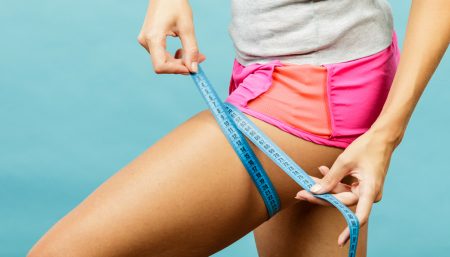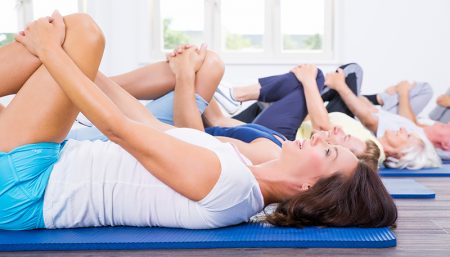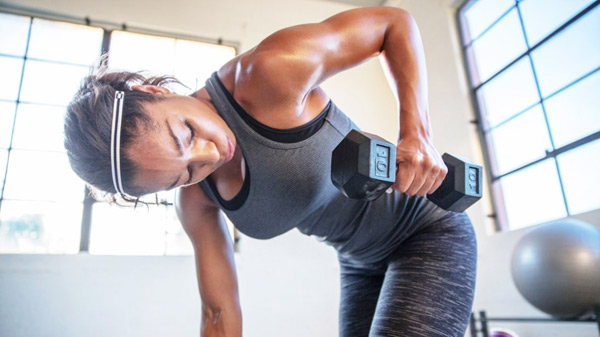
Traditionally, resistance training often is performed separately from aerobic training — typically on two or three non-consecutive days each week. The American College of Sports Medicine (ACSM) recommends 8 to 12 repetitions of a resistance training exercise for each major muscle group at an intensity of 40% to 80% of a one-repetition max (RM) depending on the training level of the participant. Two to three minutes of rest is recommended between exercise sets to allow for proper recovery. Two to four sets are recommended for each muscle group.
The following is an example of a 12-station High-Intensity Circuit Training (HICT) program. HICT is not a new concept, but it is growing in popularity because of its efficiency and practicality for a time-constrained society. The combination of aerobic and resistance training in a high-intensity, limited-rest design can deliver numerous health benefits in much less time than traditional programs.
All exercises can be done with body weight and implements easily acquired in almost any setting (e.g., home, office, hotel room, etc.). The exercise order allows for a total body exercise to significantly increase the heart rate while the lower, upper, and core exercises function to maintain the increased heart rate while developing strength.
Exercises are performed for 30 seconds, with 10 seconds of transition time between bouts.
Total time for the entire circuit workout is approximately 7 minutes. The circuit can be repeated 2 to 3 times.
- Jumping jacks (Total body) : Stand up straight with your feet shoulder-width apart and let your arms hang down by your sides. Jump up just off of the ground and spread your legs, while quickly raising your arms high up over your head until your hands almost touch. Keep your hands open with your palms facing away from you during the first part of the movement. Bring your feet back to shoulder width while quickly lowering your arms back down to your sides to finish the first jumping jack repetition. Continue to repeat the exercise for as long as you want to work on your cardiovascular fitness. If you start to experience any pain in your shoulders, either slow down the pace of the jumping jacks or do not raise your arms quite as high.
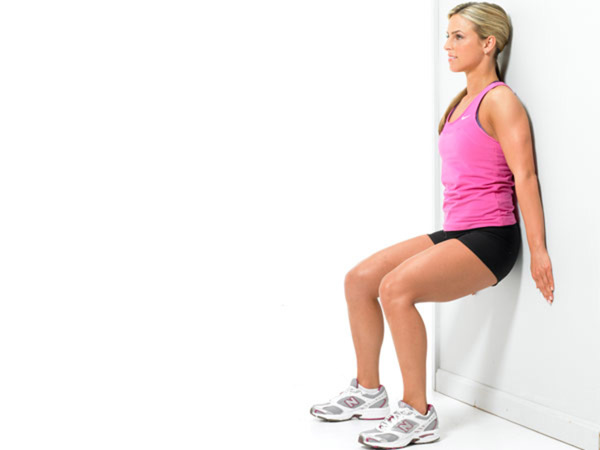
- Wall sit (Lower body): Slowly slide your back down the wall until your thighs are parallel to the ground. Adjust your feet if you need to so that your knees are directly above your ankles (rather than over your toes). Keep your back flat against the wall. Hold the position for 20 to 60 seconds, rest 30 seconds, and repeat the exercise three times. Increase your hold time by five seconds as you increase your strength.
- Push-up (Upper body): Assume a prone position on the floor or other hard surface that’s able to support your body weight. Keep your feet together. Place your hands under your shoulders with your palms on the ground. Curl your toes upward (towards your head) so that the balls of your feet touch the ground. Raise yourself using your arms. At this point, your weight should be supported by your hands and the balls of your feet. This position is called “plank,” which is used for other various exercises. This is the beginning and the end position of a single push-up. Lower your torso to the ground until your elbows form a 90 degree angle. Keep your head facing forward. Try to have the tip of your nose pointed directly to the front as you’re going down. Draw a breath as you lower yourself. Raise yourself by attempting to push the ground away from you. Breathe out as you push. The power for that push will inevitably come from your shoulders and chest. The triceps are also contracted but the primary exercise for the triceps isn’t the push-up. Continue the push until your arms are just about straight. Stretch the chest and shoulder muscles during your cool down cycle.
- Abdominal crunch (Core): Lie on a mat face up. Bend your knees until your legs are at a 45-degree angle with both feet on the floor. Your back should be comfortably relaxed on the floor. Place both hands crossed gently over your chest or on the sides of your head with the fingertips touching gently. Contracting your abdominals, raise your head and legs off the floor toward one another. Make sure you crunch hard and tight. I want you to hold the contraction at the top of the movement for one second. Slowly return to the starting position, stopping just short of your shoulders and feet touching the floor. Exhale while rising up and inhale while returning to the starting position. Keep your eyes on the ceiling to avoid pulling with your neck.
- Step-up onto chair (Total body): Use a chair or a bench or any platform that is between 1ft -2ft high and can bear weight. Step up onto the chair and strike the opposite knee as you stand up. Replace the elevated leg to the ground and continue working one side at a time.
- Squat (Lower body): Stand in the basic position with your feet parallel, legs slightly bent and the feet not wider apart than your hips. The tip of your feet should be pointing outwards with your stomach and buttock tense, and the head in line with the spine. Bend your knees and lower your body. Upper part of the body will lean a little forward during the course of the exercise. Bend, till the legs are at an angle of about 90%. After stretching, your legs return back to the starting position. Don’t forget to breathe correctly during the course of the exercise. Remember to keep your knees, thighs and tip of feet in line, besides you should be able to see the tips of your feet in front of your knees even in the end position.
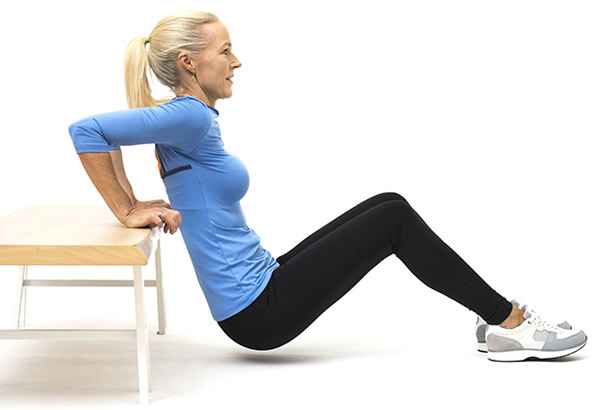
- Triceps dip on chair (Upper body): Sit with the heels of your hands on the edge of a sturdy chair seat. Slide your butt off the seat, and support your weight with your hands. Straighten your right leg; your left leg should be bent at about a 90-degree angle. Bend your elbows back, and slowly lower your butt toward the floor. Keep your elbows tucked in. Your body should just clear the seat. Push back up until your arms are straight; don’t use your feet for help. Do one set of 8 to 15 repetitions. Repeat with your left leg extended.
- Plank (Core): Get in a pushup position but instead of resting on your hands, you rest on your forearms. You hold your back completely straight while trying to hold your abdominals in. While it may sound easy, the longer you try to perform a plank, the harder it will be. You might start with 30 second sets and work your way up to 2-3 minutes. Repeat for 3-5 reps. For the obliques, try lifting your right leg and bending at the knee, twist slightly at the trunk and reach your knee towards your hip. Return to plank pose position and repeat up to 25 times, once done repeat with your other leg. Repeat this move on both sides for 15 to 25 repetitions. Engage your abs not your lower back. You can even perform this exercise while standing.
- High knees/running in place (Total body ): To perform the high knees exercise, the athlete should start in a standing position on the balls of his or her feet. Starting with either leg, the athlete raises the leg until the knee is at at least a 90 degree angle. Another way to ensure that the knee is high enough is to make sure that the foot of the raised leg is higher than the knee of the stationary leg. The athlete then lowers that leg to the ground and the repeats the process with the other leg.
- Lunge (Lower body): Stand with right foot forward, left foot back about 3 feet apart. Hold weights in each hand if desired and bend the knees to lower the body towards the floor. Keep the front knee behind the toes and be sure to lower straight down rather than forward. Keep the torso straight and abs in as you push through the front heel and back to starting position. Don’t lock the knees at the top of the movement. Perform 1-3 sets of 8-16 reps according to your fitness level and goals. Walking lunges as well as side lunges, are a great way to tone legs without using a machine.

- Push-up and rotation (Upper body): Perform push-up. At top of movement, rotate body into side-plank position with one arm on ground and other extended toward ceiling. Slowly rotate back to top of push-up position. Perform push-up and repeat rotation to opposite side.
- Side plank (Core): Lie on side on mat. Place forearm on mat under shoulder perpendicular to body. Place upper leg directly on top of lower leg and straighten knees and hips. Raise body upward by straightening waist so body is ridged. Hold position. Repeat with opposite side.
The exercises should be performed in rapid succession, allowing 30 seconds for each, while, throughout, the intensity hovers at about an 8 on a discomfort scale of 1 to 10, The seven minutes should be, in a word, unpleasant. The upside is, after seven minutes, you’re done.
Contraindications:
- Caution should be taken when prescribing this protocol to individuals who are overweight/obese, detrained, previously injured, or elderly or for individuals with comorbidities.
- For individuals with hypertension or heart disease, the isometric exercises (wall sit, plank, and side plank) are not recommended.
- As with all exercise programs, prior medical clearance from a physician is recommended.
High-intensity circuit training seems to deliver numerous health benefits in less time than more traditional programs that are recommended. Furthermore, body weight can be used as resistance, eliminating the need for specialized facilities or equipment.
Reference
Disclaimer
The Content is not intended to be a substitute for professional medical advice, diagnosis, or treatment. Always seek the advice of your physician or other qualified health provider with any questions you may have regarding a medical condition.
